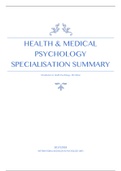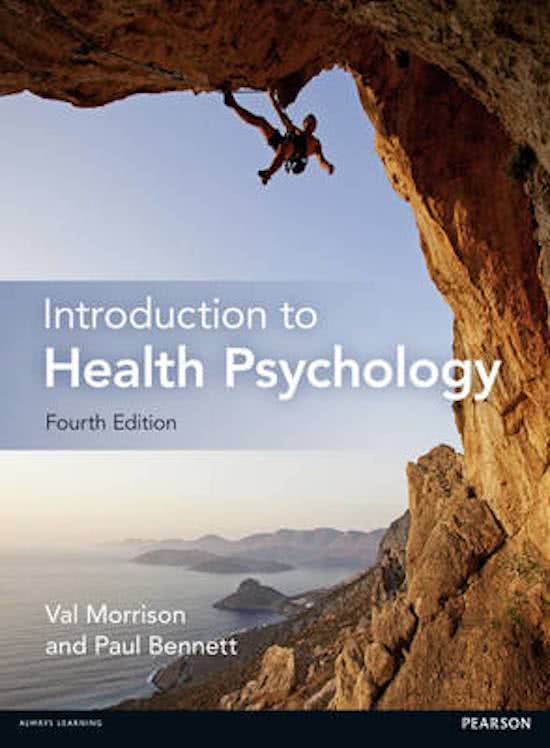HEALTH & MEDICAL
PSYCHOLOGY
SPECIALISATION SUMMARY
Introduction to Health Psychology, 4th Edition
2017/2018
INTERNATIONAL BACHELOR IN PSYCHOLOGY (IBP)
,Chapter 1 – What is Health?
Views of Health have shifted from fairly holistic views to more dualist views and is now shifting
back to towards holism.
Hippocrates: Humoral Theory of Illness
Mind and body as one unit and that it was a balance between four circulating body fluids that
were healed by rebalancing.
v Yellow Bile v Blood
v Phlegm v Black Bile
Galen: Physical or pathological basis for all ill health. The mind and body were interrelated, but
only in terms of physical and mental disturbances both having an underlying physical cause.
Descartes: Dualism. Allowed dissection and autopsy to be accepted by the church as the soul
is supposed to have left the body. Mechanistic viewpoint lead treatment to become more
technical, diagnostic and focused on physical evidence.
Biomedical Model of Illness
Health is defined as the absence of disease and any symptom is thought to be pathological
and medically treatable.
Proponents dealing only with objective facts and assuming a direct causal relationship between
illness or disability and adjustment outcomes.
Allows little room for subjectivity. Reductionist view. Ignores that different people respond in
different ways to the same underlying disease.
Psychosocial Models of Health and Illness
Subjectivity in terms of beliefs, expectations and emotions interact with bodily reactions to
play an important role in the illness or stress experience.
Freud: Psychosomatic Medicine, illnesses with no physical evidence are known as
psychogenic.
Biopsychosocial Model of Illness
Emphasises the interaction between body and mind, between the biological processes and
psychological and social influences. Increased recognition of the role of individual behaviour.
The leading causes of death in the modern world have a behavioural component. Our own
behaviour contributes significantly to our health and mortality.
Top 5 Killers by 2020:
1. Heart Disease 4. Throat Cancer
2. Cerebrovascular Disease 5. Lung Cancer
3. Lower Respiratory Infections
Lay Theories of Health
People with diagnoses of quite serious illness made three main types of response whereby
being healthy was related to:
v Feeling v Performance
v Symptom Orientation
The way that we think about health is often multifaceted. Health is a relative state of being.
1
,Subjective health judgements were more tied to health behaviour in ‘healthier individuals’.
6 main ways that health was found to be identified
• Health as not ill • Health as physical fitness and vitality
• Health as reserve • Health as psychosocial well-being
• Health as behaviour • Health as function
WHO: A state of complete physical, mental and social well-being and…not merely the absence
of disease or infirmity.
Health policy acknowledges the evidenced relationship between people’s behaviour, lifestyles
and their health. The policies aim to secure health security for all, global health equity,
increased life expectancy, and access for all to essential health care.
Bircher: A dynamic state of well-being characterised by a physical and mental potential, which
satisfies the demands of life commensurate with age, culture and personal responsibility.
What is considered to be ‘normal’ health varies across cultures and as a result of the economic,
political and cultural climate of the era in which someone lives.
Such beliefs can influence disclosure of symptoms and health-seeking behaviour.
Westerners divide the mind, body and soul in terms of allocation of care between
psychologists, psychiatrists, medical professions and the clergy. Easterners have a more
holistic view.
Collectivistic cultures emphasise group needs and find meaning through links with others and
one’s community to a greater degree than individualistic (western) ones. Makes them more
likely to view health in terms of social functioning rather than simply personal functioning.
Biomedical view is acknowledged and assimilated within different culture’s belief systems.
Developmental Theories
Development is a function of the interaction between 3 factors:
v Learning v Maturation
v Experience
Erikson: Eight major life stages which varied across different dimensions:
• Cognitive and Intellectual • The Understanding of Illness
Functioning • Health Care and Maintenance
• Language and Communication Skills Behaviour
Piaget: proposed a staged structure to which all individuals follow in sequence
1. Sensorimotor
2. Preoperational
o Not very sympathetic to an ill family member
o Explain illness on a ‘magical’ level
§ Incomprehension, Phenomenonism, Contagion
3. Concrete operational
o More concrete explanations and based on a causal sequence
§ Contamination, Internalisation
o Encouraged to take some personal control over their illness or treatment
2
, 4. Formal Operational
o Illness concepts are at an abstract level
§ Physiological
§ Psychophysiological
Adults are less likely than adolescents to adopt new health-risk behaviour and are generally
more likely to engage in protective behaviour.
Bowling and Iliffe: five progressively more inclusive ‘models’ of successful ageing
1. Biomedical Model
2. Broader Biomedical Model
3. Social Functioning Model
4. Psychological Resources Model
5. Lay Model
i. Strongest prediction of good QoL
Health Psychology integrates many cognitive, developmental and social theories and
explanations, and applies hem solely to health, illness and health care.
Main Goals is to develop the understanding of biopsychosocial factors involved in:
• Promotion and Maintenance of Health
• Improving Health Care Systems and Health Policy
• Prevention and Treatment of Illness
• Causes of Illness
Psychosomatic Medicine -> Behavioural Medicine -> Medical Psychology -> Medical Sociology
-> Clinical Psychology -> Health Psychology
Health Psychology considers the biological, social and psychological factors involved in
the aetiology, prevention or treatment of physical illness, as well as in the promotion
and maintenance of health.
3





